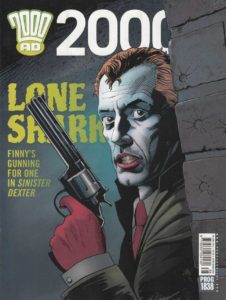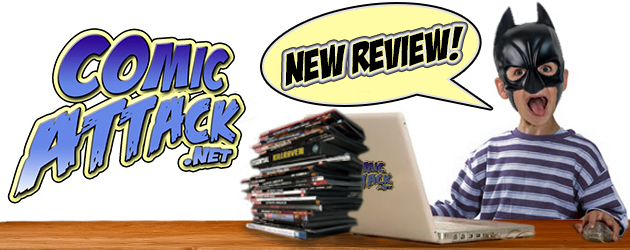[dropcap]A[/dropcap]re you ready guys and gals? It’s going down in a big way because New York Comic Con is THIS WEEKEND and it’s shaping up to be the biggest one yet.
The pop culture smorgasbord kicks off on Friday, October 10, 2014 and right at its heart taking its well-deserved place as a part of the mainstream is the comic book. From movies to TV to web series, the geek’s best kept secret for intrigue and a break from the same ole is not so secret anymore and ComicAttack.Net couldn’t be happier to share our love affair with art, literature and the creators who make it all possible with the world.
 It is in that spirit that we would like to introduce you to Monty Nero; A Creator To Watch.
It is in that spirit that we would like to introduce you to Monty Nero; A Creator To Watch.
Monty is the tremendously British-named author/artist whose work has been featured in the perennial British Sci-Fi anthology 2000AD and also wrote this year’s AMAZING X-MEN ANNUAL #1 with artist Salvador Larroca. A multitalented, multifaceted guy who is equally at home penning post-punk sci-fi super power epics as he is doing 3D modeling for video games. He just also happens to be the guy who created what Buzzfeed called “The Best British Comic in years” for Titan Comics called Death Sentence.
ComicAttack.net got a chance to pick his brains about his art and his passions as well as go deep on Death Sentence Vol. 1 and bring you perhaps the greatest, smartest conversation about comics the internet has ever seen. Bombast? Maybe you’ll have to read on to find out.
Comic Attack: Thanks for taking the time to speak to us. I really enjoy a good tale of sex, power and mortality and this did not disappoint. Where did the idea for Death Sentence come from?
Monty Nero: I’d been talking to people at a comic con about how the comics I was reading didn’t seem to reflect the world around us: the language; the tone – the real interests we all share. On the drive home I realized that I had to put my money where my mouth was. My wife was three months pregnant at the time and all the parents we knew were issuing dark warnings that life as we knew it would end in an explosion of nappies and baby milk. So it felt like I only had six months left to do something creative – to realize my artistic dreams – before settling down to all this responsible Dad stuff. Which wasn’t true, as it turned out – because new life is hugely creative and inspiring. But that powerful feeling is at the heart of the book: ‘6 months to live – What are you gonna do?’ In my case I wanted to make a great comic.
CA: Well congrats on that. You absolutely made one.
MN: Thank you very much.
CA: Now while some might boil down the plot of Death Sentence into “What if AIDS made you an X-man” I read it more as a critique of our celebrity obsessed culture but also the pervasive ennui inherent in an artist’s life. There are even elements of the ancient fear that you can lose your artistic gifts by exploiting them for your own gain.
MN: Yeah, that’s an interesting point. [The narative] is more about the role of art for the individual though.
CA: Well in a world like the one you created what do you think becomes the function of art and the artist?
MN: We deal with wider questions for society in the sequel. Creativity is exciting but it can also be very destructive. It can ruin your life, leave you penniless, spent, homeless. I know a few brilliant artists who’ve ended up that way. But still we create. So creativity seems to be something integral, an essential part of ourselves, that;s deeper than logical thought. A lot of people become wildly creative when facing death. You spend time creating a painting or music because its an essential part of yourself to engage in that process. And what is left on the canvas is part of you, it’s everything you were for six hours, or however long it took to create, all that concentration, thought, emotion, physical control – it’s all now a picture or a song. Whoever buys it has that part of you, those moments of your life, on their wall for as long as they want. It’s a beautiful thing.
CA: I thought it was interesting that the final showdown was between two struggling artists fighting with their perceptions and pain against a famous- for-nothing celebrity wielding his arrogance made force. What inspired that matchup?
MN: 21st Century culture. I think it’s pretty unambiguous. Future generations will look back at our society as a time of baffling spiritual and intellectual vacuousness. They’ll look back on Miley Cyrus and all our entertainingly hedonistic leisure pursuits with the same sad wonder we reserve for bear fights and lead painted faces. Death Sentence looks to shine a Dickensian light on modern life.
CA: What were some of the significant comic storylines that had a big effect on you as a kid?
MN: Umm… Mazzucchellis run on Daredevil was something else. I hated his style at first because it was so loose and sketchy and I was just an ignorant child. But he completely won me over. He’s the absolute master of choosing the exact right moment, and angle, and body posture to convey whatever the story needs in each panel. He’s a wonderful storyteller, and he sweated buckets over every page. Born Again was obviously the pinnacle of that run, and it had a huge effect on me.
CA: So out of all your work in the mediums of comics and video games which of your works are you most proud of and why?
MN: Death Sentence, because it’s more personal. That’s why I got into writing comics. I wanted to create something creator owned, something of lasting value. Games sell millions, but they’re the work of big teams and your contribution is homogenized. With Death Sentence there’s no meetings, no compromises, and no group-think corporate marketing solution stamped onto whatever we’re creating. It’s just two people, the writer and artist, pure and unadulterated, and that’s what people are responding to. If it ever creases to be that, then I’ll just stop doing it and make something else instead.
CA: If you could get free reign with any character in comics which character would you choose and what would you want to do with them?
MN: Ummm. Superman. I could do some amazing things with Superman, make him relevant and cool again, a truly inspirational hero. The answers right there, I don’t know why they’re not doing it. But it’s never going to happen, so I’ll just apply it to my own characters.
CA: How do you feel about Reticons (retroactive continuity changes) and their use in mainstream characters storylines from the big publishers?
 MN: I’m much more interested in a good story, than slavish adherence to any previously established doctrines. Be bold, I say. Though I do think understanding the original core of a character is key to writing it well. You have to respect the heritage. If you can keep the same origin but put an interesting new spin on things that’s satisfying, I think.
MN: I’m much more interested in a good story, than slavish adherence to any previously established doctrines. Be bold, I say. Though I do think understanding the original core of a character is key to writing it well. You have to respect the heritage. If you can keep the same origin but put an interesting new spin on things that’s satisfying, I think.
CA: Who are some of your favorite writers and artist working today?
MN: Too many to list. This month I’m really enjoying comics from INJ Culbard, The Talbots, Al Ewing, Mark Millar and Matt Fraction.
CA: Are there any triple-a or indie titles that you are looking forward to on the video game front?
MN: Evolve looks genuinely innovative. There’s always a lot of next gen guff around with new consoles, but this has the air of something new. And Hack Run was a really good mobile game, full of the atmosphere Watch Dogs was lacking, so anything from i273 is worth checking out.
CA: Can you tell me about some of your upcoming projects?
MN: I’m working on a new crime horror comic which I’m really excited about. And a 30 page Hulk story which’ll be out in September…and the Death Sentence sequel of course.
CA: Finally, what are you reading right now and what can you recommend something that might not be on everyone’s radar right now?
MN: Celeste by INJ Culpbard is well worth a read.
Monty Nero won’t be able to make it to this years NYCC but he will be releasing new info about Death Sentence Vol. 2.
Keep it here for all the updates and follow Monty on Twitter and pick up Death Sentence Vol. 1 in book stores everywhere!
[signoff]



Fantastic interview guys! It’s good to see we’ll be getting more Death Sentence as well!